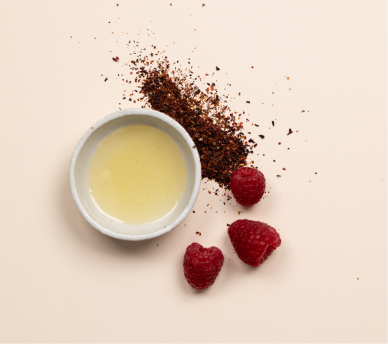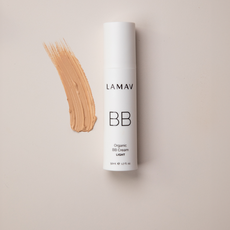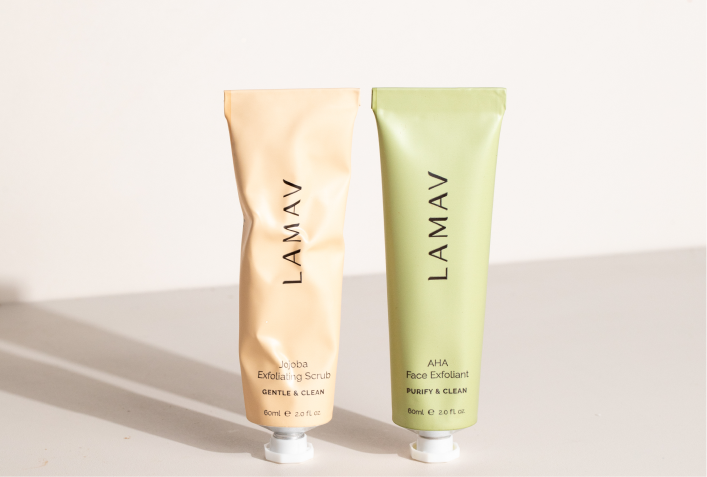What is Exfoliation?
If you use skincare regularly, you've probably come across the term exfoliation and may already use the best exfoliator for face as part of your weekly ritual. But if you’re new to exfoliants or simply using one without really understanding why it matters or which type is best for your skin it’s time to get clear on this essential skincare step.
Our skin naturally renews itself by shedding dead skin cells approximately every 28 to 30 days a process known as cellular turnover. However, this natural exfoliation can become sluggish due to factors like ageing, hormonal changes, environmental pollutants, and even product buildup. The result? Dry patches, dullness, clogged pores, and uneven skin tone.
By integrating the right best exfoliator for face suited to your skin type, you can support this natural process, revealing smoother, brighter, and more radiant skin.
Regular exfoliation helps:
- Improve skin texture and tone Prevent acne and clogged pores
- Boost collagen production
- Enhance the absorption of serums and moisturizers
- Stimulate cell renewal for a radiant complexion
Why You Need to Exfoliate
As we age or face changes in lifestyle or climate, our skin may struggle to shed dead cells on its own. This buildup can lead to:
- Rough, flaky texture
- Dullness and uneven tone
- Congested pores and breakouts
- Decreased effectiveness of skincare products
Regular exfoliation helps remove dead skin cells, excess oil, dirt, and debris, creating a clean canvas for serums and moisturizers to penetrate deeper. It also boosts collagen production, which supports skin firmness and elasticity key factors in youthful-looking skin.
Whether you're targeting acne, hyperpigmentation, or simply want glowing skin, using the best face exfoliator tailored for your skin type makes all the difference.
Types of Exfoliants: Which One Is Right for You?
There are many types of exfoliants and methods of exfoliation, and you may be surprised to learn that it’s not all about scrubbing. There are two main types of exfoliants chemical vs physical exfoliants and some formulations combine the two together.
Physical Exfoliants
Physical exfoliants use small particles or tools to manually slough off dead skin cells from the surface of your skin. Common examples include:
- Exfoliating face scrubs
- Jojoba bead cleansers
- Dry brushes
- Exfoliating mitts
- Microdermabrasion devices
They often provide instant results but must be used with caution, especially for sensitive or acne-prone skin. Harsh particles like walnut shells or sugar can cause microtears or irritation.
Chemical Exfoliants
Chemical exfoliants dissolve the glue that holds dead skin cells together using active acids. These are typically more gentle and effective over time.
The most common types are:
- AHAs (Alpha-Hydroxy Acids): Glycolic, lactic, tartaric, and citric acids. Ideal for dry, dull, and ageing skin.
- BHAs (Beta-Hydroxy Acids): Salicylic acid. Best for oily and acne-prone skin as it penetrates pores and removes excess oil.
- PHAs (Poly-Hydroxy Acids): Lactobionic acid, gluconolactone. Great for sensitive skin as they exfoliate without deep penetration or irritation.
Pro Tip: If you're new to acids, start with PHAs or low-concentration AHAs, then gradually work your way up.
Exfoliating Face Wash vs Face Scrub: What's the Difference?
When choosing your best exfoliating face wash or best exfoliating face scrub, it’s helpful to understand their differences. Exfoliating face washes typically contain gentle chemical exfoliants or fine physical particles that cleanse while lightly exfoliating. In contrast, face scrubs often have coarser granules or beads for manual exfoliation, providing a more tactile sensation.
If you have sensitive skin, a gentle exfoliator for sensitive skin in the form of an exfoliating face wash may be preferable. For those who enjoy a deeper, more hands-on exfoliation, a face scrub can be effective but should be used cautiously to avoid irritation.
How to Choose the Right Exfoliation Product for Your Skin Type
Using exfoliation products that don’t support your skin type may result in irritation and could lead to a damaged skin barrier. It’s important to identify your skin type before choosing an exfoliant and ensure it contains naturally derived ingredients that provide effective results without irritating the skin. Below are our 5-star rated top-performing exfoliant recommendations based on your skin type.
Best Exfoliators for Sensitive Skin
Main Concerns:
Sensitive skin often reacts quickly to harsh ingredients, physical scrubs, or high-strength acids, resulting in redness, stinging, or flare-ups.
Best Exfoliants:
Gentle is the name of the game here. Look for chemical exfoliants like lactic acid or polyhydroxy acids (PHAs) such as gluconolactone. These work slowly and hydrate while exfoliating. Avoid strong physical scrubs or anything labeled "deep exfoliation" or "microdermabrasion."
LAMAV Recommendation:
LAMAV’s Jojoba Exfoliating Scrub is ideal for sensitive skin types. It combines fruit-derived AHAs with melting jojoba micro-beads, a kinder physical option to gently resurface without scratching. Soothing botanicals like Aloe Vera and Chamomile help reduce inflammation and redness while nourishing oils provide moisture.
Best Exfoliators for Dry Skin
Main Concerns:
Dry skin struggles with flakiness, dull tone, and sometimes irritation. Exfoliating helps improve texture and allows better absorption of moisturizers.
Best Exfoliants:
Opt for hydrating chemical exfoliants like lactic acid, which pulls moisture into the skin while sloughing off dead cells. You can use glycolic acid if your skin isn’t reactive, but avoid salicylic acid as it can worsen dryness.
LAMAV Recommendation:
LAMAV’s Jojoba Exfoliating Scrub delivers hydration and exfoliation in one step. Fruit-derived AHAs tackle rough patches, while jojoba beads buff gently. It's also rich in nourishing oils to prevent moisture loss during exfoliation.
Best Exfoliators for Oily, Combination & Acne-prone Skin
Main Concerns:
This skin type often deals with congestion, enlarged pores, and breakouts. The goal is to clear pore buildup without over-drying.
Best Exfoliants:
Go for salicylic acid (BHA) to penetrate deep into oily pores, or glycolic acid (AHA) to remove surface buildup. A combo of chemical and non-abrasive physical exfoliants often works well here.
LAMAV Recommendation:
LAMAV’s AHA Face Exfoliant is a powerhouse for oily and acne-prone skin. It combines potent AHAs (from Desert Lime, Sugar Cane, and Bilberry) with Bamboo Powder and Diatomaceous Earth for gentle buffing. The result? Clear, smooth, and balanced skin without compromising barrier health.
Best Exfoliators for Normal Skin
Main Concerns:
Normal skin may not face frequent breakouts or dryness, but that doesn’t mean it doesn’t benefit from regular exfoliation to maintain clarity and glow.
Best Exfoliants:
Both physical and chemical exfoliants can work here. You can choose based on texture preference AHAs for brightness or gentle scrubs for a tactile refresh.
LAMAV Recommendation:
If you like a creamy feel, go with our Jojoba Exfoliating Scrub. Prefer more texture? Try LAMAV’s AHA Face Exfoliant. Both support healthy skin turnover and deliver bio-active botanical benefits.
Best Exfoliators for Mature Skin
Main Concerns:
As we age, skin renewal slows down, leading to dullness, uneven tone, and fine lines. Exfoliation is key for radiance and better absorption of anti-aging products.
Best Exfoliants:
Lactic acid is ideal because it’s both exfoliating and hydrating. Glycolic acid is also effective for deeper resurfacing. Avoid harsh physical exfoliants, as mature skin can be thinner and more prone to damage.
LAMAV Recommendation:
LAMAV’s Jojoba Exfoliating Scrub provides gentle exfoliation with fruit acids, helping to refine texture without irritation. The jojoba beads melt into the skin, and nourishing oils support collagen and elasticity.
How to Exfoliate Properly (Without Damaging Your Skin)
Exfoliation may seem like a simple skincare step but there are a few things to consider if you want to get the most out of your exfoliant while limiting irritation.
When to Use a Face Exfoliant
For best results, use your exfoliant after a double cleanse. Cleansing first ensures your exfoliant can work on fresh skin, allowing active ingredients like AHAs, BHAs, PHAs to penetrate more effectively.
Pro Tip: Skipping your cleanser before exfoliation can leave behind residue that prevents the exfoliant from working efficiently.
Day or Night: What’s the Best Time to Exfoliate?
Should I exfoliate in morning or night? Nighttime is ideal for exfoliating. Here’s why:
- Your skin is cleanest after your evening routine.
- You’re more likely to follow up with hydrating serums, facial oils, or night creams that help calm the skin post-exfoliation.
- Freshly exfoliated skin is more sensitive to sunlight, so exfoliating at night reduces the risk of UV-related irritation.
How Often Should You Exfoliate?
How often to exfoliate? More isn’t always better. Whether you have dry patches or acne-prone skin, avoid the urge to exfoliate daily. Over-exfoliating can lead to redness, tightness, flaking, or even increased breakouts.
General rule: 2–3 times per week is enough for most skin types. Start slow and monitor how your skin reacts.
Skip Harsh Actives Right After Exfoliating
After exfoliating, your skin barrier is more vulnerable. While it's a great time to apply nourishing treatments, avoid strong actives like:
- Retinol
- Vitamin A
- High concentrations of AHAs/BHAs
These can increase irritation or cause peeling when layered over freshly exfoliated skin.
Should Skin Be Wet or Dry Before Exfoliating?
It depends on the exfoliant:
- Physical exfoliants (like scrubs) should be applied to clean, damp skin. Water softens the skin and allows for gentler exfoliation.
- Chemical exfoliants (like lactic or glycolic acid) are typically used on dry
Don’t Exfoliate the Eye Area
The skin around your eyes is thin and delicate, making it more prone to damage. Whether you’re using a scrub or acid-based exfoliant, avoid the under-eye and eyelid area. Focus instead on:
- T-zone
- Cheeks
- Chin and jawline
Body-specific products
If you’re using a body scrub on your face, please stop! The skin on our face is more delicate and prone to irritation than the skin on our body, so it’s important to use a product on the face that is dedicated to facial exfoliation.
Body exfoliation is often something that is not made a priority on our list of self-care rituals. We get it, most of us are busy and short on time so feel that skincare time would be best invested on the face. If this sounds like you, we have good news! Body exfoliation can be achieved in just a few minutes per day and has a long list of benefits.
Garshana Dry Body Brushing

LAMAV’s Garshana Dry Body Brush does more than just exfoliate. Indulging in this ancient Ayurvedic ritual for a few minutes prior to showering will stimulate lymphatic drainage and boost circulation while sloughing away dead skin cells for brighter, firmer skin.
Exfoliating Mitt

Designed to be used for tanning prep and overall skin health, LAMAV’s Exfoliating Mitt gently buffs away blemishes, bumps and dry skin to smooth and tone the skin, helping to reduce the appearance of cellulite. This reusable mitt is washable and reusable, making it a must have in everyone’s bathroom.
See Real Results and Reviews Below from Our Exfoliation Range













